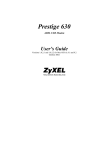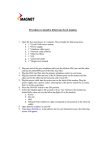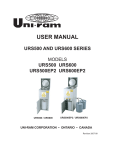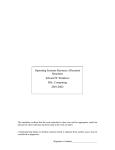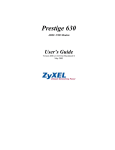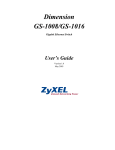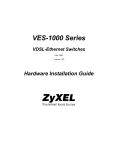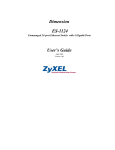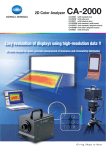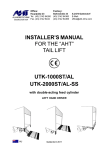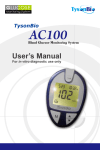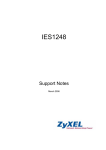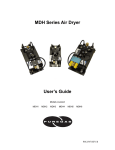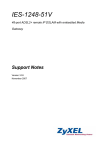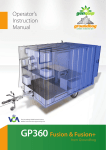Download IES-2000/3000 Hardware Installation Guide
Transcript
IES-2000 Integrated Ethernet Switch Version 2.00 February 2003 User’s Guide IES-2000 User’s Guide Copyright Copyright © 2003 by ZyXEL Communications Corporation. The contents of this publication may not be reproduced in any part or as a whole, transcribed, stored in a retrieval system, translated into any language, or transmitted in any form or by any means, electronic, mechanical, magnetic, optical, chemical, photocopying, manual, or otherwise, without the prior written permission of ZyXEL Communications Corporation. Published by ZyXEL Communications Corporation. All rights reserved. Disclaimer ZyXEL does not assume any liability arising out of the application or use of any products, or software described herein. Neither does it convey any license under its patent rights nor the patent rights of others. ZyXEL further reserves the right to make changes in any products described herein without notice. This publication is subject to change without notice. Trademarks Trademarks mentioned in this publication are used for identification purposes only and may be properties of their respective owners. ii Copyright IES-2000 User’s Guide Interference Statements and Warnings FCC Interference Statement: This device complies with Part 15 of the FCC rules. Operation is subject to the following two conditions: (1) This device may not cause harmful interference. (2) This device must accept any interference received, including interference that may cause undesired operations. FCC Warning! This equipment has been tested and found to comply with the limits for a Class A digital device, pursuant to Part 15 of the FCC Rules. These limits are designed to provide reasonable protection against harmful interference in a commercial environment. This equipment generates, uses, and can radiate radio frequency energy and, if not installed and used in accordance with the instruction manual, may cause harmful interference to radio communications. Operation of this equipment in a residential area is likely to cause harmful interference in which case the user will be required to correct the interference at his own expense. CE Mark Warning: This is a class A product. In a domestic environment this product may cause radio interference in which case the user may be required to take adequate measures. Taiwanese BSMI A Warning: Certifications Refer to the product page at www.zyxel.com. Interference Statements and Warnings iii IES-2000 User’s Guide ZyXEL Limited Warranty ZyXEL warrants to the original end user (purchaser) that this product is free from any defects in materials or workmanship for a period of up to two years from the date of purchase. During the warranty period, and upon proof of purchase, should the product have indications of failure due to faulty workmanship and/or materials, ZyXEL will, at its discretion, repair or replace the defective products or components without charge for either parts or labor, and to whatever extent it shall deem necessary to restore the product or components to proper operating condition. Any replacement will consist of a new or re-manufactured functionally equivalent product of equal value, and will be solely at the discretion of ZyXEL. This warranty shall not apply if the product is modified, misused, tampered with, damaged by an act of God, or subjected to abnormal working conditions. Note Repair or replacement, as provided under this warranty, is the exclusive remedy of the purchaser. This warranty is in lieu of all other warranties, express or implied, including any implied warranty of merchantability or fitness for a particular use or purpose. ZyXEL shall in no event be held liable for indirect or consequential damages of any kind of character to the purchaser. To obtain the services of this warranty, contact ZyXEL's Service Center for your Return Material Authorization number (RMA). Products must be returned Postage Prepaid. It is recommended that the unit be insured when shipped. Any returned products without proof of purchase or those with an out-dated warranty will be repaired or replaced (at the discretion of ZyXEL) and the customer will be billed for parts and labor. ZyXEL will ship all repaired or replaced products to the corresponding return address, Postage Paid. This warranty gives you specific legal rights, and you may also have other rights that vary from country to country. iv Warranty IES-2000 User’s Guide Customer Support Please have the following information ready when you contact customer support. Product model and serial number. Warranty information. Date that you received your device. Brief description of the problem and the steps you took to solve it. METHOD E-MAIL SUPPORT/SALES TELEPHONE/FAX WEB SITE/ FTP SITE REGULAR MAIL LOCATION WORLDWIDE [email protected] +886-3-578-3942 www.zyxel.com www.europe.zyxel.com NORTH AMERICA SCANDINAVIA GERMANY Customer Support [email protected] +886-3-578-2439 ftp.europe.zyxel.com [email protected] +1-714-632-0882 800-255-4101 www.zyxel.com [email protected] +1-714-632-0858 ftp.zyxel.com [email protected] +45-3955-0700 www.zyxel.dk [email protected] +45-3955-0707 ftp.zyxel.dk [email protected] +49-2405-6909-0 www.zyxel.de [email protected] +49-2405-6909-99 [email protected] +603-795-34-407 ZyXEL Communications Corp., 6 Innovation Road II, ScienceBased Industrial Park, Hsinchu 300, Taiwan. ZyXEL Communications Inc., 1650 Miraloma Avenue, Placentia, CA 92870, U.S.A. ZyXEL Communications A/S, Columbusvej 5, 2860 Soeborg, Denmark. ZyXEL Deutschland GmbH. Adenauerstr. 20/A2 D-52146 Wuerselen, Germany v IES-2000 User’s Guide Table of Contents Copyright ...................................................................................................................................................................ii Interference Statements and Warnings .................................................................................................................... iii ZyXEL Limited Warranty...........................................................................................................................................iv Customer Support .....................................................................................................................................................v List of Figures ...........................................................................................................................................................ix List of Tables.............................................................................................................................................................xi Preface .................................................................................................................................................................... xii Hardware Overview ....................................................................................................................................................................... I Chapter 1 Hardware Overview ....................................................................................................................... 1-1 1.1 Front Panel ............................................................................................................................................ 1-1 1.2 Features ................................................................................................................................................. 1-1 1.3 Applications .......................................................................................................................................... 1-2 Installation..................................................................................................................................................................................... II Chapter 2 Chassis Installation........................................................................................................................ 2-1 2.1 General Installation Instructions ........................................................................................................... 2-1 2.2 Rack-mounted Installation Requirements ............................................................................................. 2-1 2.3 Mounting the IES-2000 Chassis on a Rack........................................................................................... 2-1 2.4 Connecting the Frame Ground .............................................................................................................. 2-2 Chapter 3 Card Installation............................................................................................................................. 3-1 3.1 Installing a Main Chassis Card.............................................................................................................. 3-1 3.2 Removing a Main Chassis Card ............................................................................................................ 3-2 3.3 Installing a Splitter Chassis Card .......................................................................................................... 3-4 3.4 Removing a Splitter Chassis Card......................................................................................................... 3-4 Connections ................................................................................................................................................................................. III Chapter 4 4.1 Chapter 5 Front Panel Connections............................................................................................................... 4-1 Making Card Connections..................................................................................................................... 4-1 MDF Connections.......................................................................................................................... 5-1 5.1 MDF Connections Overview ................................................................................................................ 5-1 5.2 MDF (Main Distribution Frame)........................................................................................................... 5-1 Table of Contents vii IES-2000 User’s Guide 5.3 Telco-50 Cables.....................................................................................................................................5-2 5.4 Splitter Chassis Rear Panel Connections...............................................................................................5-2 5.5 MDF Scenarios......................................................................................................................................5-3 5.6 Typical MDF Scenarios.........................................................................................................................5-3 Chapter 6 Power Connections........................................................................................................................ 6-1 6.1 Power Connections Overview ...............................................................................................................6-1 6.2 Power Connections................................................................................................................................6-1 6.3 Procedure to Turn on the IES-2000 Power............................................................................................6-2 Maintenance................................................................................................................................................................................. IV Chapter 7 Fan Maintenance ........................................................................................................................... 7-1 7.1 Fan Maintenance Introduction...............................................................................................................7-1 7.2 Removing and Installing the Fan Module .............................................................................................7-1 Chapter 8 Power Maintenance ....................................................................................................................... 8-1 8.1 Procedure to Disconnect the Power.......................................................................................................8-1 8.2 Procedure to Change an IES-2000 Power Fuse.....................................................................................8-1 8.3 Procedure to Reconnect the Power........................................................................................................8-2 Chapter 9 Hardware Troubleshooting ............................................................................................................ 9-1 9.1 The SYS or PWR LED Does Not Turn On ...........................................................................................9-1 9.2 The ALM LED Is On ............................................................................................................................9-1 9.3 A DSL LED Does Not Turn On ............................................................................................................9-2 9.4 No Voice on an ADSL or VDSL Connection .......................................................................................9-2 9.5 The WAN Link is Down .......................................................................................................................9-3 9.6 Testing Wiring.......................................................................................................................................9-3 Appendices and Index ................................................................................................................................................................. V Appendix A Safety Warnings ....................................................................................................................................A Appendix B Hardware Specifications .......................................................................................................................B Index .........................................................................................................................................................................E viii Table of Contents IES-2000 User’s Guide List of Figures Figure 1-1 IES-2000 Front Panel .............................................................................................................................. 1-1 Figure 1-2 Application Overview Example .............................................................................................................. 1-3 Figure 1-3 IP DSLAM Application Example............................................................................................................ 1-3 Figure 1-4 MTU Application Example ..................................................................................................................... 1-4 Figure 2-1 Rack Mounting the Chassis ..................................................................................................................... 2-2 Figure 2-2 IES-2000 Main Chassis Frame Ground................................................................................................... 2-3 Figure 2-3 IES-2000 Splitter Chassis Frame Ground ............................................................................................... 2-3 Figure 3-1 Installing a Main Chassis Card................................................................................................................ 3-1 Figure 3-2 Closing the Ejector Levers ...................................................................................................................... 3-2 Figure 3-3 Tightening Main Chassis Card Thumbscrews ......................................................................................... 3-2 Figure 3-4 Loosening Main Chassis Card Thumbscrews.......................................................................................... 3-3 Figure 3-5 Opening the Ejector Levers ..................................................................................................................... 3-3 Figure 3-6 Removing a Main Chassis Card .............................................................................................................. 3-3 Figure 3-7 Installing a Splitter Chassis Card ............................................................................................................ 3-4 Figure 3-8 Tightening Splitter Chassis Card Thumbscrews...................................................................................... 3-4 Figure 3-9 Loosening Splitter Chassis Card Thumbscrews ...................................................................................... 3-5 Figure 3-10 Removing a Splitter Chassis Card ......................................................................................................... 3-5 Figure 4-1 IES-2000 Front Panel Telco-50 Connections .......................................................................................... 4-1 Figure 5-1 MDF (Main Distribution Frame) Wiring................................................................................................. 5-1 Figure 5-2 Telco-50 Cable with RJ-11 Connectors ................................................................................................... 5-2 Figure 5-3 Installation Overview Example ............................................................................................................... 5-3 Figure 5-4 Installation Scenario A ............................................................................................................................ 5-4 Figure 5-5 One MDF for End-user and CO Connections ......................................................................................... 5-4 Figure 5-6 Installation Scenario B ............................................................................................................................ 5-5 Figure 5-7 Two Separate MDFs for End-user and CO Connections......................................................................... 5-6 Figure 5-8 Installation Scenario C ............................................................................................................................ 5-7 Figure 6-1 Connecting IES-2000 Power ................................................................................................................... 6-2 Figure 7-1 IES-2000 Fan Module Thumbscrews ...................................................................................................... 7-1 Figure 7-2 Removing the IES-2000 Fan Module...................................................................................................... 7-2 List of Figures ix IES-2000 User’s Guide Figure 7-3 IES-2000 Fan Fuses.................................................................................................................................7-2 Figure 8-1 IES-2000 Power Fuses.............................................................................................................................8-1 Figure 9-1 Testing In-house Wiring...........................................................................................................................9-4 x List of Figures IES-2000 User’s Guide List of Tables Table 9-1 SYS LED Troubleshooting ....................................................................................................................... 9-1 Table 9-2 ALM LED Troubleshooting ...................................................................................................................... 9-1 Table 9-3 DSL LED Troubleshooting ....................................................................................................................... 9-2 Table 9-4 Voice Troubleshooting .............................................................................................................................. 9-2 Table 9-5 WAN Link Troubleshooting...................................................................................................................... 9-3 Table 9-6 Testing Wiring........................................................................................................................................... 9-4 List of Tables xi IES-2000 User’s Guide Preface Congratulations on your purchase of the IES-2000 Integrated Ethernet Switch. About this User’s Manual This user’s guide gives hardware installation, connection and maintenance instructions. It also gives specifications. Online Registration Register your ZyXEL product online at www.zyxel.com for free future product updates and information. General Syntax Conventions For brevity’s sake, we will use “e.g.,” as shorthand for “for instance”, and “i.e.,” for “that is” or “in other words”. Naming Conventions The IES-2000 may be referred to as the IES. IES-2000 refers to the IES-2000 main chassis and its cards along with the IES-2000 splitter chassis and its cards. The IES-2000M is the IES-2000 main chassis. The IES-2000ST is the IES-2000 splitter chassis with Telco-50 connectors. The IES-2000SW is the IES-2000 splitter chassis with wire wrapping pins. The MSC1000, MSC1000A or MSC1000AL (Management Switch Card) may be referred to as the switch card or MSC. The EEC1020 (Ethernet Extension Card) may be referred to as the EEC. Related Documentation DSL Line Card User’s Guides These user’s guides provide hardware connection details and explain how to configure and manage the individual line cards. Management Switch Card User’s Guide This user’s guide provides hardware connection details and configuration and management instructions for the management switch card. EEC1020 User’s Guide These user’s guides provide hardware connection details for the Ethernet Extension Card. Glossary and ZyXEL Web Site Please refer to www.zyxel.com for an online glossary of networking terms or the ZyXEL download library for additional support documentation. xii Preface Hardware Overview Part I: Hardware Overview This part introduces the Integrated Ethernet Switch and gives some application examples. I IES-2000 User’s Guide Chapter 1 Hardware Overview This chapter describes the key features, specifications and applications of your IES-2000. The IES-2000 (Integrated Ethernet Switch) is an IP-based DSLAM (Internet Protocol Digital Subscriber Line Access Multiplexer) that connects DSL subscribers to the Internet. As a high-performance but yet compact and versatile platform, it can conveniently deliver broadband Internet access to telephone company central offices, multi-tenant units (MTUs), hospitals, hotels, schools, university campuses and ISPs. The IES-2000’s low cost and easy management make it a perfect DSL-provider solution. The IES-2000 platform allows for convenient management and support of various DSL technologies. With the ability to hold a maximum of five line cards, up to 120 DSL subscribers can simultaneously utilize a wide range of powerful broadband services. Additionally, the DSL line cards are hot swappable; thus, you do not need to interrupt the service of other cards to change or service an individual card. A single management switch card can provide the convenience of centralized network traffic supervision. 1.1 Front Panel The following figure shows the front panels of the IES-2000 main chassis and splitter chassis with installed line and splitter cards. Figure 1-1 IES-2000 Front Panel 1.2 Features Main Chassis Hardware Overview 1-1 IES-2000 User’s Guide The main chassis has slots for hot-swappable DSL line cards and a management switch card or Ethernet extension card. Splitter Chassis The splitter chassis has slots for hot-swappable splitter and extension cards, and Telco-50 connectors or wire wrapping pins for connecting to the subscribers and the PBX (Private Branch Exchange) or PSTN/ISDN (Public Switched Telephone Network)(Integrated Services Digital Network) switch. Hot Swappable DSL Line Cards The IES-2000 uses hot swappable DSL line cards. Hot Swappable Splitter Cards The IES-2000 uses hot swappable splitter cards. Management Switch Card The IES-2000 accommodates a management switch card that switches traffic and forwards it between the DSL line cards and other Ethernet switches. Ethernet Extension Card The IES-2000 accommodates an Ethernet extension card that allows you to make an Ethernet connection to each DSL line card for uplink and management. Hot Swappable Fan Module The IES-2000 is equipped with a hot swappable fan module to provide easy maintenance, greater reliability and increased system operating lifetimes. Power Module You can easily access the IES-2000’s power module to change a fuse. Scalable Platform for Future Expansion The flexible design of the IES-2000 allows service providers to start with minimum cost. As the number of users and applications increases, additional DSL line cards can be added to support more subscribers. 1.3 Applications The following sections describe example applications for the IES-2000. This figure gives an example overview. 1-2 Hardware Overview IES-2000 User’s Guide Figure 1-2 Application Overview Example 1.3.1 IP DSLAM The IES-2000 operates as an IP DSLAM in a telephone company’s central office. It provides DSL service over telephone wires to subscribers. The following figure shows the IES-2000 set up in a telephone company’s central office. Figure 1-3 IP DSLAM Application Example Hardware Overview 1-3 IES-2000 User’s Guide 1.3.2 MTU Application The following figure depicts a typical application of the IES-2000 in a large residential building, or multiple tenant unit (MTU), that leverages the existing phone line wiring to provide Internet access to subscribers in the building. A subscriber connects a computer to the phone line in a unit using an ADSL modem. The other end of the phone line is connected to a port on the IES-2000. The IES-2000 aggregates the traffic from subscribers and then forwards it through an Ethernet connection to the Internet. Figure 1-4 MTU Application Example 1-4 Hardware Overview Installation Part II: Installation This part describes how to install the IES-2000 chassis and cards. II IES-2000 User’s Guide Chapter 2 Chassis Installation This chapter shows you how to install hardware for a rack-mounted scenario. 2.1 General Installation Instructions Read all the safety warnings in the appendix before you begin and make sure you follow them. Perform the installation as follows: Step 1. Make sure the IES-2000 power switch is in the OFF position. Step 2. Refer to this chapter for details on installing the main and splitter chassis. Make sure you connect the frame grounds before you make any other connections (refer to section 2.4). Step 3. If either the main chassis cards or the splitter cards are not already installed, follow the procedure in Chapter 3 to install them. Step 4. Refer to the chapter on front panel connections for instructions on making front panel connections for the cards. Step 5. Refer to the chapter on MDF connections for instructions on making rear panel connections for the splitter chassis. Step 6. Refer to the chapter on power connections for instructions on making power connections and turning on the IES-2000. 2.2 Rack-mounted Installation Requirements Make sure the rack will safely support the combined weight of all the equipment it contains. Make sure the position of the IES-2000 does not make the rack unstable or top-heavy. Take all necessary precautions to anchor the rack securely before installing the unit. Use a #2 Philips screwdriver to install the screws. Refer to the Hardware Specifications appendix for the gauge of wire to use for the frame ground connections. Refer to the Hardware Specifications appendix for the hardware that is required to mount the IES-2000. Failure to use the proper screws may damage the unit. 2.3 Mounting the IES-2000 Chassis on a Rack Make sure that nothing obstructs the airflow of the main chassis. Chassis Installation 2-1 IES-2000 User’s Guide If you are facing the IES-2000 main chassis front panel, the fan exhaust vents are located on the right side panel of the unit and the fans along with the intake vents are located on the left side panel. Use the following procedure to install the chassis in the rack. Install the main chassis and splitter chassis in a rack with the splitter chassis directly below the main chassis. Step 1. Position a mounting bracket (that is already attached to the chassis) on one side of the rack, lining up the screw holes on the bracket with the screw holes on the side of the rack (see the figure shown next). Step 2. Use the screwdriver to install the screws through the mounting bracket holes into the rack. Step 3. Repeat Step 1and Step 2 to attach the second mounting bracket on the other side of the rack. Figure 2-1 Rack Mounting the Chassis 2.4 Connecting the Frame Ground Refer to the Hardware Specifications appendix for the ground wire gauge. The IES-2000 main chassis frame ground is on the lower left corner of the front panel. The IES-2000 splitter chassis has two frame grounds is on the rear panel of the main chassis. Connect the frame grounds to a building’s protective earthing terminals using a green-and-yellow frame ground wire. Warning! Connect the frame ground before you connect any other cables or wiring. 2-2 Chassis Installation IES-2000 User’s Guide Frame Ground Figure 2-2 IES-2000 Main Chassis Frame Ground Figure 2-3 IES-2000 Splitter Chassis Frame Ground Chassis Installation 2-3 IES-2000 User’s Guide Chapter 3 Card Installation This chapter shows you how to install and remove main chassis and splitter chassis cards. 3.1 Installing a Main Chassis Card Use the following procedure to install a management switch card or a DSL line card in the main chassis. Install the line cards starting from the bottommost slot. Install a management switch card or Ethernet extension card in slot 1 on the IES-2000. Step 1. Grasp the center of the front panel of the card with one hand and place the other hand under the card to support it. Step 2. Insert the card halfway into the slot and spread the two ejector levers outward. Make sure the ejector levers are perpendicular to the front panel. Step 3. Slide the card into the slot until it makes contact with the backplane. The ejector levers should be at a small angle to the front panel now. Step 4. Push the two ejector levers firmly until they are flush with the front panel. Step 5. Tighten the two thumbscrews. Figure 3-1 Installing a Main Chassis Card Card Installation 3-1 IES-2000 User’s Guide Figure 3-2 Closing the Ejector Levers Figure 3-3 Tightening Main Chassis Card Thumbscrews 3.2 Removing a Main Chassis Card Step 1. Disconnect all cables from the card. Step 2. Loosen the two thumbscrews. Step 3. Pull the two ejector levers firmly until the front of the card is clear of the chassis. Pull the ejector levers until they are perpendicular to the front panel. Step 4. Grasp the center of the front panel of the card with one hand and place the other hand under the card to support it. Step 5. Slide the card out of the slot. 3-2 Card Installation IES-2000 User’s Guide Figure 3-4 Loosening Main Chassis Card Thumbscrews Figure 3-5 Opening the Ejector Levers Figure 3-6 Removing a Main Chassis Card Card Installation 3-3 IES-2000 User’s Guide 3.3 Installing a Splitter Chassis Card The splitter card’s type and slot number must match those of the DSL line card to which it is to connect. For example, connect a VSC1012 in slot 2 of the splitter chassis if there is a VLC1012 in slot 2 of the main chassis. Do not use the unnumbered splitter slot; leave its slot cover on. Use the following procedure to install a splitter card in the splitter chassis. Step 1. Install the splitter card in the same slot number on the splitter chassis as the corresponding line card in the main chassis (the management switch card or Ethernet extension card does not need a splitter chassis card). Step 2. Grasp the center of the front panel of the card with one hand and place the other hand under the card to support it. Step 3. Insert the card into the slot and push it in until the front panel of the card is flush with the front panel of the splitter chassis. Step 4. Tighten the two thumbscrews. Figure 3-7 Installing a Splitter Chassis Card Figure 3-8 Tightening Splitter Chassis Card Thumbscrews 3.4 Removing a Splitter Chassis Card Use the following procedure to remove a splitter card from the IES-2000 splitter chassis. 3-4 Card Installation IES-2000 User’s Guide Step 1. Disconnect the cable from the card. Step 2. Loosen the two thumbscrews. Step 3. Grasp the handles on the front panel of the card and start to pull the card out. Step 4. After you have the card partially out of the chassis, place one hand under the card to support it. Step 5. Slide the card out of the slot. Figure 3-9 Loosening Splitter Chassis Card Thumbscrews Figure 3-10 Removing a Splitter Chassis Card Card Installation 3-5 Connections Part III: Connections This part describes how to connect the IES-2000 to a Main Distribution Frame (MDF) and connect the power. III IES-2000 User’s Guide Chapter 4 Front Panel Connections This chapter explains how to connect the cards. 4.1 Making Card Connections The following describes how to connect the DSL line cards to the splitter chassis cards. For the Ethernet extension card or the management switch card, refer to the card’s User’s Guide for instructions on making the connections. 4.1.1 DSL Line Card Connections Use the optional Telco-50 cable to connect the DSL line card’s front panel Telco-50 connector to the corresponding splitter card’s front panel Telco-50 connector. See the hardware specifications in the appendices for what lengths of ZyXEL’s optional Telco-50 cables to use. Make sure that you use the appropriate length Telco-50 cables with the DSL line cards in the IES2000; using cables of the wrong length blocks access to other cards. Figure 4-1 IES-2000 Front Panel Telco-50 Connections Front Panel Connections 4-1 IES-2000 User’s Guide Chapter 5 MDF Connections This chapter shows you how to connect the splitter chassis’s rear panel to an MDF. 5.1 MDF Connections Overview Observe the following before you start: Images of the IES-2000ST (Splitter chassis with Telco-50 connectors) rear panel are used throughout this chapter. Connections for the splitter chassis with wire wrapping pins use the same pin assignments. Refer to the hardware specifications in the appendices for the gauge of telephone wire to use. Follow the pin assignments shown in the DSL line card’s User’s Guide to wire Telco-50 cables to Telco-50 connectors. Refer to the User’s Guide of your management switch card or Ethernet extension card for details on how to make the management connections. 5.2 MDF (Main Distribution Frame) An MDF is usually installed between subscribers’ equipment and the telephone company (CO) in a basement or telephone room. The MDF is the point of termination for the outside telephone company lines coming into a building and the telephone wiring in the building. Figure 5-1 MDF (Main Distribution Frame) Wiring Connect wiring to end-user equipment to the lower ports of an MDF and connect wiring from the telephone company to the upper ports of an MDF (see the previous figure). MDF Connections 5-1 IES-2000 User’s Guide Some MDFs have surge protection circuitry built in between the two banks; thus, do not connect telephone wires from the telephone company directly to your IES. Use a punch-down tool to seat telephone lines into MDF blocks. Multiple upper and lower MDF port connections are shown as one line in the following figures. 5.3 Telco-50 Cables Telco-50 cables are used for data and voice applications with MDFs (Main Distribution Frame), patch panels and distribution boxes. They can also be used as extension cables. Telco-50 cables are made up of 25 twisted-pair copper wires. Connect a Telco-50 connector to one end of the cable (see the appendices for pin assignments) and connect the other end directly to an MDF; alternatively attach RJ-11 connectors and connect directly to DSL modem(s). Figure 5-2 Telco-50 Cable with RJ-11 Connectors 5.4 Splitter Chassis Rear Panel Connections A DSL splitter card separates the voice signal from the DSL signal. It feeds the DSL signal to the DSL line card and diverts the voice signal to the CO Telco-50 connector (or wire wrapping pins) on the splitter chassis’s rear panel. Connect the CO Telco-50 connector or wire wrapping pins to the PBX or PSTN/ISDN switch when using the ADSL splitter card or VDSL splitter card. Connect the USER Telco-50 connector (or wire wrapping pins) to the subscribers’ telephone wiring. In most multitenant unit applications, the USER pins connect to the subscribers’ telephone wiring via Main Distribution Frame (MDF). See the pin assignments in the DSL line card’s User’s Guide and the section on MDF scenarios for details on splitter chassis rear panel connections. 5-2 MDF Connections IES-2000 User’s Guide 5.5 MDF Scenarios The following figure gives an overview on a possible installation scenario for the IES-2000 using the ADSL or VDSL line and splitter cards. Data and voice signals can coexist on the same telephone wiring. Figure 5-3 Installation Overview Example You can also attach RJ-11 connectors to the Telco-50 cable and connect directly to a DSL modem(s) or patch panel. This chapter discusses connections using MDFs. 5.6 Typical MDF Scenarios This section describes typical installation scenarios. 5.6.1 Installation Scenario A You want to install the IES-2000 in an environment where there are no previously installed MDFs. There is no phone service and you want to install the IES-2000 for data-access only. No connection from the Telco-50 CO connector is necessary. G.SHDSL connections carry data only, thus they are best suited to this installation scenario. You may connect using an MDF or attach RJ-11 connectors to the non-IES-2000 end of the Telco-50 cable and then connect to DSL modems directly. MDF Connections 5-3 IES-2000 User’s Guide Figure 5-4 Installation Scenario A Procedure to Connect to an MDF Step 1. Connect the Telco-50 connector end of the cable to the Telco-50 connector labeled USER on the splitter chassis rear panel. Step 2. Connect the wiring on the other end of the Telco-50 cable to the upper ports of the MDF using a punch-down tool. Step 3. Connect the telephone wiring from each end-user’s DSL modem to the lower ports of the MDF. 5.6.2 Installation Scenario B Phone service is available. There is one MDF from which end-users CO connections are made (see next figure). This installation scenario does not apply to G.SHDSL connections. Figure 5-5 One MDF for End-user and CO Connections 5-4 MDF Connections IES-2000 User’s Guide This installation scenario requires three MDFs. Please refer to the following figure for the connection schema. MDF 1 is the original MDF used for telephone connections only. MDF 2 is used for telephone connections only. MDF 3 is for DSL service connections. Change the wiring from MDF 1 to MDF 3 for telephone subscribers who want DSL service. Figure 5-6 Installation Scenario B Procedure to Connect to MDFs Step 1. Connect the Telco-50 connector end of the cable you want for DSL service to the Telco-50 connector labeled USER on the splitter chassis rear panel. Step 2. Connect the wiring on the other side of the Telco-50 cable to the upper ports of MDF 3 using a punch-down tool. Step 3. Connect the telephone wiring from the end-user’s DSL modem(s) to the lower ports of MDF 3. Step 4. Connect the Telco-50 connector end of the cable you want for phone service to the Telco-50 connector labeled CO on the splitter chassis rear panel. Step 5. Connect the wiring on the other side of the Telco-50 cable to the lower ports of MDF 2 using a punch-down tool. Step 6. Connect the upper ports of MDF 2 to the lower ports of MDF 1 using telephone wires. Step 7. Connect the upper ports of MDF 1 to the telephone company. MDF Connections 5-5 IES-2000 User’s Guide Step 8. Telephone subscribers only (non-DSL subscribers) retain connections to the lower ports of MDF 1. Step 9. Change the wiring from MDF 1 to MDF 3 for telephone subscribers who want DSL service. 5.6.3 Installation Scenario C Phone service is also available but there are two MDFs; one for end-user telephone line connections and the other one for CO telephone wiring connections (see the following figure). This installation scenario does not apply to G.SHDSL connections. Users A and B have telephone (only) service. Figure 5-7 Two Separate MDFs for End-user and CO Connections This installation scenario requires four MDFs. Please refer to the following figure for the DSL connection schema. MDFs 1 and 2 are the two original MDFs. MDFs 3 and 4 are two additional MDFs you need. User A still has telephone service only. User B now has telephone and DSL service (see the following figure) 5-6 MDF Connections IES-2000 User’s Guide Figure 5-8 Installation Scenario C Procedure to Connect to MDFs Step 1. Connect the Telco-50 connector end of the cable you want for DSL service to the Telco-50 connector labeled USER on the splitter chassis rear panel. Step 2. Connect the wiring on the other side of the Telco-50 cable to the upper ports of MDF 3 using a punch-down tool. Step 3. Connect the lower ports of MDF 3 to the upper ports of MDF 2 for those users that want DSL service. (Users who want telephone service only, retain the original connection from the top port of MDF 2 to the bottom port of MDF 1.) Step 4. Connect the telephone wiring from the end-user’s DSL equipment to the lower ports of MDF 2. Step 5. Connect the Telco-50 connector end of the cable you want for phone service to the Telco-50 connector labeled CO on the splitter chassis rear panel. Step 6. Connect the wiring on the other side of the Telco-50 cable to the lower ports of MDF 4 using a punch-down tool. Step 7. Connect the top ports of MDF 4 to the bottom ports of MDF 1 using telephone wires. Step 8. Connect the top ports of MDF 1 to the telephone company. MDF Connections 5-7 IES-2000 User’s Guide Chapter 6 Power Connections This chapter shows you how to connect the IES-2000 main chassis to a power source. 6.1 Power Connections Overview Use the following procedures to connect the IES-2000 to a power source after you have installed the main and splitter chassis in a rack. Refer to power supply requirements in the hardware specifications in the appendices and make sure you are using an appropriate power source. Observe the following before you start: Refer to the Hardware Specifications appendix for the gauge of wire to use for the IES-2000 power connections. Keep the IES-2000 power switch in the OFF position until you come to procedure for turning on the power. Keep the power supply switch in the OFF position until you come to procedure for turning on the power. Use only power wires of the required diameter for connecting the IES-2000 to a power supply (refer to the hardware specifications in the appendices for the required wire diameter). 6.2 Power Connections Use an AC power module or an appropriate UPS (uninterruptible power supply). Refer to the hardware specifications for the IES-2000 power requirements. The IES-2000 power connections are at the lower-left corner of the front panel of the main chassis. 6.2.1 Procedure to Connect the Power When installing the IES-2000 power wire, push the wire firmly into the terminal as deep as possible and make sure that no exposed (bare) wire can be seen or touched. Step 1. Connect one end of a power wire to the –48V power terminal on the front panel of your IES-2000 and tighten the terminal screw. Step 2. Connect the other end of the power wire to the –48V terminal on the power supply. Step 3. Repeat the previous step for the terminal labeled RTN. Power Connections 6-1 IES-2000 User’s Guide Figure 6-1 Connecting IES-2000 Power 6.3 Procedure to Turn on the IES-2000 Power 6-2 Step 1. Turn on the power supply. Step 2. Move the IES-2000 power switch to the ON position. Power Connections Maintenance Part IV: Maintenance This part describes how to change IES-2000 fuses and fan modules. It also gives troubleshooting instructions. IV IES-2000 User’s Guide Chapter 7 Fan Maintenance This chapter describes how to change a fan fuse or a fan module on the IES. 7.1 Fan Maintenance Introduction The IES-2000 has hot-swappable fan modules. Use the following procedures to remove the fan module in order to replace a fuse. Replace the entire fan module if the fuses are not the problem. Return any malfunctioning fan modules to the manufacturer. 7.2 Removing and Installing the Fan Module The IES-2000 fan module is at the left on the front panel of the main chassis. Perform the following procedure to remove the fan module in order to change a fan fuse or the fan module. Step 1. Loosen the thumbscrews on the front of the fan module. Step 2. Slide out the fan module. Step 3. Replace any fuses that are burnt out (see the hardware specifications in the appendix for fuse information). If the fuses are not the problem, use a different fan module from the manufacturer. Step 4. Slide the fan module back into the fan module slot. Step 5. Tighten the thumbscrews. Figure 7-1 IES-2000 Fan Module Thumbscrews Fan Maintenance 7-1 IES-2000 User’s Guide Figure 7-2 Removing the IES-2000 Fan Module Fuses Figure 7-3 IES-2000 Fan Fuses 7-2 Fan Maintenance IES-2000 User’s Guide Chapter 8 Power Maintenance This chapter describes how to change the IES-2000 power fuses. 8.1 Procedure to Disconnect the Power Step 1. Make sure the IES-2000 power switch is in the OFF position. Step 2. Turn off the power supply. Step 3. Disconnect the power wires from the power supply’s power terminals. Step 4. Disconnect the power wires from the IES-2000 power terminals. 8.2 Procedure to Change an IES-2000 Power Fuse The IES-2000 power is at the lower-left corner of the front panel of the main chassis. The IES-2000 power fuses are below the fan module. Use the following procedure to change an IES-2000 power fuse. Step 1. Refer to section 8.1 to disconnect the power before you begin. Step 2. Refer to section 7.2 to remove the fan module. Step 3. Replace any fuses that are burnt out (see the hardware specifications in the appendix for fuse information). Step 4. Slide the fan module back into the fan module slot. Step 5. Tighten the fan module thumbscrews. Fuses Figure 8-1 IES-2000 Power Fuses Power Maintenance 8-1 IES-2000 User’s Guide 8.3 Procedure to Reconnect the Power Step 1. Reconnect the power wires to the IES-2000’s power terminals. Step 2. Reconnect the power wires to the power supply’s power terminals. Step 3. Turn the power supply back on. Step 4. Turn the IES-2000 power switch back to the ON position. 8-2 Power Maintenance IES-2000 User’s Guide Chapter 9 Hardware Troubleshooting This chapter explains how to troubleshoot IES-2000 hardware. Refer also to the Troubleshooting chapters in the card User’s Guides. 9.1 The SYS or PWR LED Does Not Turn On Table 9-1 SYS LED Troubleshooting STEP CORRECTIVE ACTION 1 Make sure the power wires are properly connected to the power supply and the power supply is operating normally. Make sure you are using the correct power source (refer to the hardware specifications in the appendices). 2 Make sure the power wires are connected properly. 3 Make sure the main chassis card is properly installed in the main chassis. 4 Make sure the power fuses are not burnt-out. Replace any burnt out fuses. Refer to the section on power module maintenance. 5 The LED itself or the unit may be faulty; contact your vendor. 9.2 The ALM LED Is On The management switch card’s ALM (alarm) LED lights when the IES-2000 is overheated and/or the fans are not working properly and/or voltage readings are outside the tolerance levels. The ALM (alarm) LEDs on the DSL line cards light when the card is overheated and/or voltage readings are outside the tolerance levels. Table 9-2 ALM LED Troubleshooting STEP CORRECTIVE ACTION 1 Go to the Hardware Monitor screen in the web configurator to verify the cause of the alarm. See step 2 if the unit is overheated, step 3 if the problem is with the fans and step 4 if the voltages are out of the allowed ranges. 2 Ensure that the IES-2000 is installed in a well-ventilated area and that normal operation of the fans is not inhibited. Keep the bottom, top and all sides clear of obstructions and away from the exhaust of other equipment. 3 Make sure you can feel and/or hear the fans working - working fans emit a low buzz and blow air. If the fans are not working properly, refer to the sections on the fan modules for instructions on changing a fuse or changing the fan module. 4 If the voltage levels are outside the allowed range, take a screen shot of the Hardware Monitor web configurator screen and contact your vendor. Hardware Troubleshooting 9-1 IES-2000 User’s Guide 9.3 A DSL LED Does Not Turn On The DSL LEDs show the operational status of the DSL port connections If a DSL LED is off, it means the link to the DSL modem/router is down. Table 9-3 DSL LED Troubleshooting STEP CORRECTIVE ACTION 1 Ensure that all hardware connections are properly made (including the modem/router on the subscriber’s side) and that all devices are turned on. 2 Make sure the DSL port is enabled (refer to the User’s Guide). 3 Check the DSL line pin assignments shown in the appendix. 4 Check the telephone wire connections between the G.SHDSL modem/router and the MDF(s). 5 Check the telephone wire and connections between the MDF(s) and DSL port(s). 6 Check the telephone wire mapping on the MDF(s) – see the chapter on MDF connections. 7 Make sure the in-house wiring works and is connected properly to the MDFs. 8 Make sure the line speed is consistent between the IES-2000 side and the CPE (Customer Premise Equipment) side. 9 If your line quality is low, you may need to select a slower line speed for both the IES-2000 and CPE sides. Refer to the User’s Guide. 9.4 No Voice on an ADSL or VDSL Connection The ADSL and VDSL line and splitter cards allow the telephone wiring used for ADSL and VDSL connections to also simultaneously carry normal voice conversations. Table 9-4 Voice Troubleshooting STEP CORRECTIVE ACTION 1 Make sure the subscriber has a POTS splitter properly installed. 2 Check the telephone wire connections between the subscriber and the MDF(s). 3 Check the telephone wire and connections between the MDF(s) and USER port(s). Refer to the pin assignments shown in the appendix. 4 Check the telephone wire and connections between the MDF(s) and the CO port(s). Check the telephone wire mapping on the MDF(s). 5 Check the connection from the MDF(s) to the PBX or the telephone company PSTN or ISDN switch. 6 Make sure the in-house wiring works and is connected properly. 7 Repeat the steps above using a different DSL port. 9-2 Hardware Troubleshooting IES-2000 User’s Guide 9.5 The WAN Link is Down Table 9-5 WAN Link Troubleshooting STEP CORRECTIVE ACTION 1 Check that the uplink and downlink ports on the management switch card are properly connected to a WAN Ethernet using either copper Ethernet cables or fiber optic cables. 2 If you enable port trunking, make sure the peer WAN switch also has port trunking enabled; see the MSC1000 User’s Guide. 9.6 Testing Wiring Use the following tests if there is no voice. Systematically test wiring using a functioning telephone to determine if there is a wiring problem. If the connection is good, the telephone will return a dial tone. Letters in the figure shown next indicate the systematic tests to be done. Suppose you’re using installation scenario “B” as shown in the chapter on MDF connections. The logic for other scenarios should be similar. Use steps A-D if there is no voice but you can transmit data. Use all of the steps if there is no voice and you cannot transmit data. A. Test A determines if there is a wiring problem between the CO and MDF 1. B. Test B determines if there is a wiring problem between MDF 1 and MDF 2. C. Test C determines if there is a wiring problem between MDF 2 and the USER Telco-50 connector on the IES-2000 splitter chassis. D. Test D determines if there is a problem with the splitter chassis card or splitter chassis. E. Test E determines if there is a wiring problem between the USER Telco-50 connector on the splitter chassis and MDF 3. F. Test F determines if there is a building-wiring problem between the subscriber’s wall jack and MDF 3. Hardware Troubleshooting 9-3 IES-2000 User’s Guide Figure 9-1 Testing In-house Wiring Table 9-6 Testing Wiring STEP TEST A Connect a standard telephone to MDF 1. If there is no dial tone, then a problem with the wire or wire connections between MDF 1 and the CO exists. Contact your telephone company for troubleshooting. B Connect a telephone to the upper port of MDF 2. If there is no dial tone, then the problem is between MDF 1 and MDF 2. Check the telephone wire and connections between MDFs 1 and 2. C Disconnect the Telco-50 cable from the splitter chassis’ Telco-50 CO connector. Connect a telephone to the appropriate pins of the Telco-50 cable’s Telco-50 connector. If there is no dial tone, then the problem is between the splitter chassis Telco-50 CO connector and MDF 2. Check the Telco-50 cable’s pin assignments (refer to the appendices for the proper pin assignments). Replace the Telco-50 cable if the pin assignments are OK and there is still no dial tone. 9-4 Hardware Troubleshooting IES-2000 User’s Guide Table 9-6 Testing Wiring STEP D TEST Reconnect the Telco-50 cable to the splitter chassis’ Telco-50 CO connector. Disconnect the Telco-50 cable from the splitter chassis’ Telco-50 USER connector. Connect a telephone to the appropriate pins of the splitter chassis’ Telco-50 USER connector (refer to the appendices for the proper pin assignments). If there is no dial tone, make sure that the splitter card is properly installed. Try a different splitter card. If using a different splitter card solves the problem, replace the first splitter card. If using a different splitter card does not solve the problem, the splitter chassis may be faulty, contact your vendor. E Reconnect the Telco-50 cable to the splitter chassis’ Telco-50 USER connector. Connect a telephone to a lower port of MDF 3. If there is no dial tone, then the problem is between the splitter chassis Telco-50 USER connector and MDF 3. Replace the Telco-50 cable connecting the USER port to MDF 3. If the problem remains, check the pin assignments of the USER Telco-50 connector. If the problem remains, then the IES-2000 or MDF 3 is faulty. Repeat the test in step A using MDF 3 to determine if MDF 3 has problems. Contact the telephone company if that is the case. If not, contact your IES-2000 vendor outlining the problem and the steps you took to solve it. F Disconnect the DSL modem from the wall jack and connect the telephone to the wall jack. If there is no dial tone, then there is a problem with the building wiring between the DSL subscriber’s home and the MDF. Contact your telephone company for troubleshooting. Hardware Troubleshooting 9-5 Appendices and Index Part V: Appendices and Index This part gives appendices and an index. V IES-2000 User’s Guide Appendix A Safety Warnings Refer to the Hardware Specifications appendix for the gauge of wire to use for each connection. The length of exposed (bare) IES-2000 power wire should not exceed 7mm. Do not use this product near water, for example, in a wet basement. Only a qualified technician should service or disassemble this device. Avoid using, servicing or disassembling this device during an electrical storm as there may be a risk of electric shock from lightning. Always disconnect all telephone lines from this device before servicing or disassembling. Fuse Warning! Replace fuse only with fuse of the same type and rating. Fan Module Warning! Use the fan module handles when pulling out or pushing in the fan module. Be careful not to put fingers or objects inside the fan module. To avoid risk of electric shock, remove only one card at a time and do not place fingers or objects inside the chassis. Cover empty slots with slot covers. Energy Hazard Warning! Remove all metal jewelry, watches, and so on from your hands and wrists before servicing this device. Safety Warnings A IES-2000 User’s Guide Appendix B Hardware Specifications This appendix gives details about the IES-2000 hardware. Physical Specifications The IES-2000 is 19 inch (482.6mm) rack-mountable. Main Chassis See the following table for the number of slots in the main chassis as well as how many are for DSL line cards and how many are for the management switch card (or Ethernet extension card). Chart 1 Main Chassis Slots NUMBER OF SLOTS: TOTAL FOR DSL LINE CARDS FOR MSC IES-2000 Main Chassis 6 5 1 IES-2000 Splitter Chassis The IES-2000ST (Splitter chassis Telco-50) or IES-2000SW (Splitter chassis Wire wrapping) each has 5 slots for cards. The IES-2000ST rear panel has six pairs of Telco-50 connectors. One USER Telco-50 connector and one CO Telco-50 connector are not used. Connect five USER Telco-50 connectors to the subscribers and five CO Telco-50 connectors to the PSTN or ISDN switch. The IES-2000SW rear panel has six sets of wire wrapping pins. One set of wire wrapping pins is not used. Connect each of the other five sets to both the subscribers (USER) and the PSTN or ISDN switch (CO). Chassis Dimensions and Weights (Without Cards) Chart 2 Chassis Dimensions and Weights (Without Cards) CHASSIS DIMENSIONS WEIGHT IES-2000 Main Chassis 4U 442.7mm (W) x 268mm (D) x 178mm (H) 8.4 kg IES-2000 Splitter Chassis 2U 442.7mm (W) x 280mm (D) x 89mm (H) 7 kg Required Mounting Hardware Chart 3 Required Mounting Hardware UNIT MOUNTING BRACKETS M4 FLAT HEAD SCREWS M5 FLAT HEAD SCREWS IES-2000 Main Chassis Four IES-2000 Splitter Chassis Four B Hardware Specifications IES-2000 User’s Guide Telco-50 Cable Lengths for Connecting to Splitter Chassis Cards Chart 4 Telco-50 Cable Lengths for Connecting to Splitter Chassis Cards CHASSIS AND CARDS ZYXEL’S TELCO 50 CABLES TO USE IES-2000’s DSL line cards in slots 5 and 6 48 cm IES-2000’s DSL line cards in slots 2 through 4 31 cm Wire Gauge Specifications Chart 5 Wire Gauge Specifications WIRE TYPE REQUIRED AWG NO. (DIAMETER) Ground Wire 18 or larger Telephone Wire 26 or larger IES-2000 Power Wire 16 to 18 AWG (American Wire Gauge) is a measurement system for wire that specifies its thickness. As the thickness of the wire increases, the AWG number decreases. Power Consumption This table describes the maximum power consumption of the IES-2000. Chart 6 Power Consumption MAXIMUM: IES-2000 WATTS VOLTS DC AMPS 300 -36 to -57 8 Use a –48VDC power source with 300W minimum output for the IES-2000. Fuse Ratings This table describes the fuse ratings of the IES-2000. Chart 7 Fuse Ratings UNIT NUMBER OF FUSES TYPE AMPS VOLTS AC DIMENSIONS IES-2000 Fan Module 2 T 0.5 250 5mm (D) x 20mm (L) IES-2000 Power 2 T 10 250 5mm (D) x 20mm (L) Operating Environment • Temperature: 0 - 50°C • Humidity: 5% - 95% (non-condensing) Storage Environment • Temperature: -25 - 70°C • Humidity: 5% - 95% (non-condensing) Hardware Specifications C IES-2000 User’s Guide Index 1 DSL Line Card Removal........................................ 3-2 19 Inch Rack .............................................................B DSL Line Card Slots .................................................B 4 DSL Line Cards ..................................................... 1-2 –48VDC ....................................................................C E A Earthing Terminal .................................................. 2-2 AC Power Module.................................................. 6-1 Ejector Levers .................................................3-1, 3-2 ALM LED .............................................................. 9-1 Electric Shock ...........................................................A ALM LED Troubleshooting................................... 9-1 Exposed IES-2000 Power Wire ................................A American Wire Gauge...............................................C F Applications ........................................................... 1-2 Fan Fuse ................................................................. 7-1 AWG .........................................................................C Fan Maintenance .................................................... 7-1 C Fan Module ............................................................ 7-1 Card Connections ................................................... 4-1 Fan Module Warning ................................................A Card Installation ..................................................... 3-1 FCC .......................................................................... iii CE Mark Warning .................................................... iii FCC Warning ........................................................... iii Certifications ............................................................ iii Features .................................................................. 1-1 Chassis Dimensions ..................................................B Frame Ground ........................................................ 2-2 Chassis Installation................................................. 2-1 Frame Ground Wire ............................................... 2-2 Chassis Weights ........................................................B Front Panel ............................................................. 1-1 CO .............................................................. B, 5-5, 5-7 Fuse Ratings..............................................................C Copyright .................................................................. ii Fuse Warning ............................................................A Customer Support...................................................... v G D General Syntax Conventions................................... xii Dimensions and Weights...........................................B Glossary and ZyXEL Web Site............................... xii Disclaimer ................................................................. ii Green-and-yellow................................................... 2-2 Disconnect the Power............................................. 8-1 Ground Wire .............................................................C DSL LED Troubleshooting .................................... 9-2 H DSL Line Card Connections .................................. 4-1 Hardware Overview ............................................... 1-1 Index E IES-2000 User’s Guide Hardware Specifications........................................... B Main Chassis Card Removal ..................................3-2 Hardware Troubleshooting.....................................9-1 Main Chassis Slots ....................................................B Hot Swappable Fan Module ...................................1-2 Main Distribution Frame........................................5-1 Humidity................................................................... C Management Switch Card ................................xii, 1-2 I MDF .......................................................................5-1 IES-2000..................................................................xii MDF Connections ..................................................5-1 IES-2000 Fan Module .............................................. C MDF Scenarios.......................................................5-3 IES-2000 Front Panel .............................................1-1 MSC ALM LED.....................................................9-1 IES-2000 Main Chassis ............................................ B MSC1000 ................................................................ xii IES-2000 Power ....................................................... C MTU Application ...................................................1-4 IES-2000 Power Connections ................................6-1 O IES-2000 Power Wire .............................................. C Online Registration ................................................. xii IES-2000 Splitter Chassis......................................... B Operating Environment IES-2000ST....................................................... B, 5-1 IES.........................................................................C IES-2000SW............................................................. B P Install......................................................................2-2 Patch Panel .............................................................5-3 Installation Requirements.......................................2-1 Philips Screwdriver, #2 ..........................................2-1 Installing a Main Chassis Card...............................3-1 Physical Specifications..............................................B Installing a Splitter Chassis Card ...........................3-4 Power......................................................................6-1 Installing the Fan Module.......................................7-1 Power Connections.................................................6-1 Interference Statements ............................................iii Power Connections.................................................6-1 IP DSLAM ..................................................... 1-1, 1-3 Power Consumption L IES.........................................................................C Levers ............................................................. 3-1, 3-2 Power Maintenance ................................................8-1 Lightning .................................................................. A Power Module ........................................................1-2 Limited Warranty ..................................................... iv Power Wire................................................................C Line Card Removal ................................................3-2 Power Wires ...........................................................6-1 List of Figures .......................................................... ix Preface..................................................................... xii List of Tables............................................................ xi Protective Earthing Terminal .................................2-2 M Punch-down Tool ...................................................5-2 Main Chassis ..................................................... B, 1-1 PWR LED ..............................................................9-1 Main Chassis Card Installation...............................3-1 PWR LED Does Not Turn On................................9-1 F Index IES-2000 User’s Guide R SYS LED Does Not Turn On................................. 9-1 Rack ....................................................................... 2-1 SYS LED Troubleshooting .................................... 9-1 Rack 19 Inch .............................................................B T Rack 482.6mm ..........................................................B Table of Contents .................................................... vii Rack-mounted Installation Requirements .............. 2-1 Taiwanese BSMI A Warning ................................... iii Reconnect the Power.............................................. 8-2 Telco-50 ....................................................................B Related Documentation ........................................... xii Telco-50 Cable....................................................... 4-1 Removing a Main Chassis Card ............................. 3-2 Telco-50 Cable Lengths ............................................C Removing the Fan Module..................................... 7-1 Telco-50 Cables ..................................................... 5-2 Required Mounting Hardware...................................B Telephone Wire.........................................................C RJ-11 Connectors ................................................... 5-2 Temperature ..............................................................C RTN........................................................................ 6-1 Testing In-house Wiring ........................................ 9-4 S Trademarks ............................................................... ii Safety Warnings ....................................................... A Turn on the Power.................................................. 6-2 Scalable Platform ................................................... 1-2 U Screwdriver ............................................................ 2-1 Uninterruptible Power Supply ............................... 6-1 Slots, Main Chassis ...................................................B UPS ........................................................................ 6-1 Splitter.................................................................... 3-5 USER ..................................................B, 5-4, 5-5, 5-7 Splitter Cards.......................................................... 1-2 V Splitter Chassis....................................................... 1-2 Voice Troubleshooting........................................... 9-2 Splitter Chassis Card Installation ........................... 3-4 W Splitter Chassis Rear Panel Connections ............... 5-2 WAN Link Troubleshooting .................................. 9-3 Splitter Chassis Telco-50 ..........................................B Warnings ............................................................. A, iii Splitter Chassis Wire Wrapping................................B Warranty .................................................................. iv Storage Environment Weights .....................................................................B IES.........................................................................C Wire Gauge ...............................................................C Surge Protection Circuitry...................................... 5-2 Wiring Testing ....................................................... 9-4 SYS LED................................................................ 9-1 Index G

































































